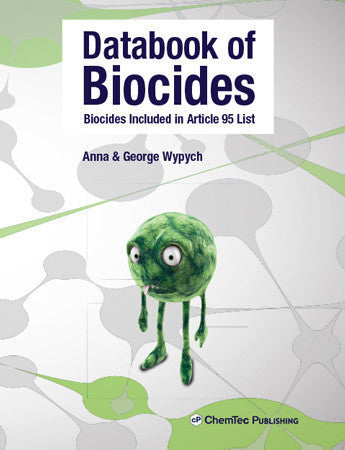This book contains data for all substances included in the Article 95 list. The substances are
arranged in alphabetical order and classified into types and groups according to the suggestions
in Annex V.
The information on each biostabilizer included in the Databook of Biocides is divided into five sections: General information, Physical properties, Health and safety, Ecological properties, and Use & Performance. The data belong to over 100 data fields, which accommodate a variety of data available in source publications. The description of each section below gives more detail on the composition of information.
In General information section, the following data are displayed: name, CAS #, EC #, IUPAC name, Common name, Common synonym, Acronym, Molecular formula, Molecular weight, Chemical category, Product type (according to EU classification), Mixture, RTECS #, Content, Used in US, Used in EU, Composition
Physical-chemical properties section contains data on State, Odor, Color, Coefficients of Antoine equation, Boiling point, Freezing point, Hansen solubility parameters, Hildebrand solubility parameter, Henry’s law constant, Refractive index, Density, Vapor density, pH, Viscosity, Surface tension, Solubility in water and solvents, Specific heat, Thermal conductivity, Heat of combustion, Volatility, Vapor pressure, Relative permittivity.
Health and safety section contains data on Flash point, Flash point method, Autoignition temperature, Explosive LEL, Explosive UEL, NFPA Classification, NFPA Health, NFPA Flammability, NFPA Reactivity, HMIS Classification, HMIS Health, HMIS Fire, HMIS Reactivity, HMIS Personal protection, UN Risk Phrases, R, UN Safety Phrases, S, DOT Hazard Class, UN/NA, ICAO/IATA Class, IMDG Class, TDG class, Proper shipping name, Rat oral LD50, Mouse oral LD50, Rabbit dermal LD50, Inhalation rat LC50, Eyes irritation, Skin irritation, Ingestion, First aid: eyes, skin, and inhalation, Target organs, Carcinogenicity, Mutagenicity, and TLV - TWA 8h (ACGIH, NIOSH, OSHA).
Ecological properties section contains data on Biodegradation probability, Bioconcentration factor, Aquatic toxicity LC50 (Algae, Rainbow trout, Bluegill sunfish, Fathead minnow, Zebra fish, and Daphnia magna), and Partition coefficient.
Use & performance section contains information on Manufacturer, Outstanding properties, Recommended for polymers, Typical applications, Active against microorganisms, Concentration used, and pH range of performance.
The book also contains introductory chapter in which general indicators of performance of biocides are discussed and a chapter containing information on the data fields included in the description of individual biostabilizers.
Anna Wypych, born in 1937, studied chemical engineering and polymer chemistry and obtained M. Sc. in chemical engineering in 1960. The professional expertise includes both teaching and research & development. Anna Wypych has published 1 book (MSDS Manual), 6 scientific papers, 3 databases, and obtained 3 patents. She specializes in polymer additives for PVC and other polymers and evaluates their effect on health and environment.
George Wypych has a Ph. D. in chemical engineering. His professional expertise includes both university teaching (full professor) and research & development. He has published 14 books: PVC Plastisols, (University Press); Polyvinylchloride Degradation, (Elsevier); Polyvinylchloride Stabilization, (Elsevier); Polymer Modified Textile Materials, (Wiley & Sons); Handbook of Material Weathering, 1st, 2nd, 3rd, and 4th Editions, (ChemTec Publishing); Handbook of Fillers, 1st and 2nd Editions, (ChemTec Publishing); Recycling of PVC, (ChemTec Publishing); Weathering of Plastics. Testing to Mirror Real Life Performance, (Plastics Design Library), Handbook of Solvents, Handbook of Plasticizers, Handbook of Antistatics, Handbook of Antiblocking, Release, and Slip Additives, PVC Degradation & Stabilization, The PVC Formulary (all by ChemTec Publishing), 47 scientific papers, and he has obtained 16 patents. He specializes in polymer additives, polymer processing and formulation, material durability and the development of sealants and coatings. He is included in the Dictionary of International Biography, Who's Who in Plastics and Polymers, Who's Who in Engineering, and was selected International Man of the Year 1996-1997 in recognition for his services to education.




